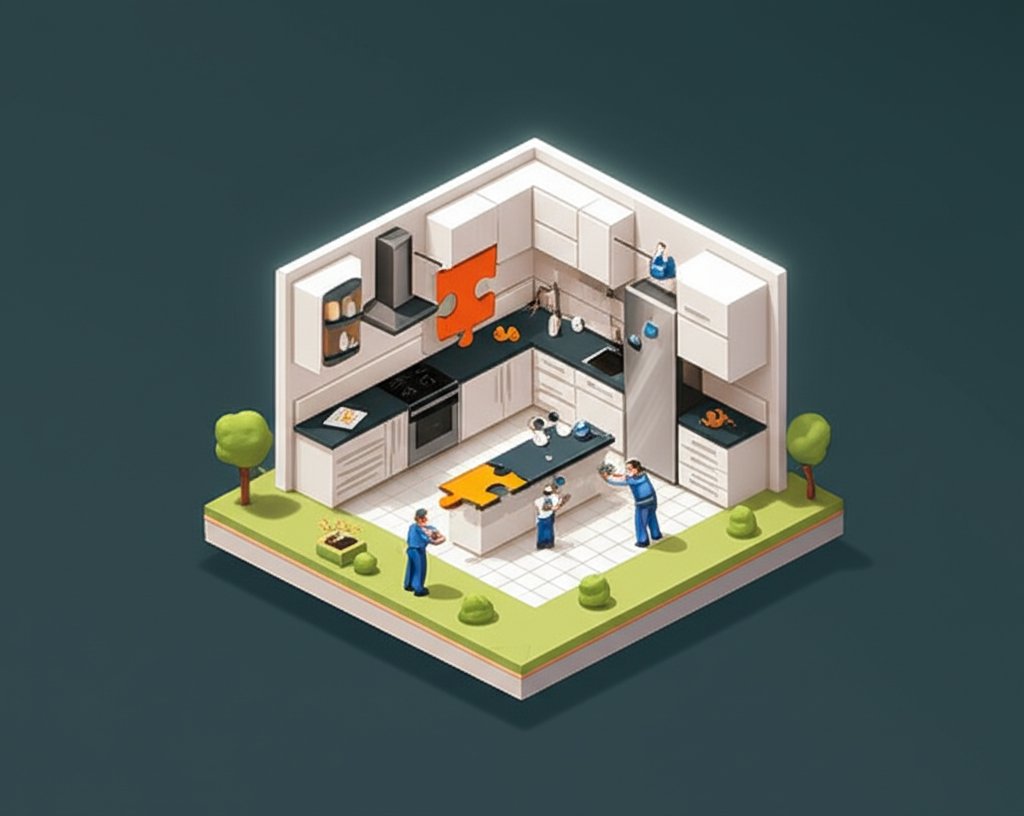Dreaming of a kitchen island but dread the weeks of construction and dust? A prefab kitchen island might be your shortcut to a stylish and functional upgrade. These ready-to-assemble islands offer a blend of convenience, affordability, and surprisingly customizable options.
At a glance:
- Discover if a prefab island fits your kitchen’s size and style.
- Weigh the pros and cons against custom-built alternatives.
- Learn how to select the right size, materials, and features.
- Understand the installation process and potential challenges.
- Get tips for customizing your prefab island to make it your own.
Why Choose a Prefab Kitchen Island?
Prefab kitchen islands offer several advantages, particularly for homeowners looking for a quick and relatively painless upgrade. The primary appeal is in its convenience. Unlike building an island from scratch or even using stock cabinets, a prefab island arrives mostly assembled, drastically reducing installation time.
Another benefit is cost. Prefab options often represent a more budget-friendly choice compared to fully custom builds. You bypass the labor costs associated with extensive carpentry and on-site construction. However, cost savings don’t have to equal compromise. To explore different design approaches to kitchen islands, consider these Build your dream island kitchen.
Prefab vs. Custom: Finding the Right Fit
Before diving into prefab options, it’s wise to assess whether a prefab island truly meets your needs compared to a custom-built solution.
- Prefab: Offers convenience, lower cost, and a range of styles. Best for standard-sized kitchens and those seeking a quick upgrade. Limitations often involve fixed dimensions and fewer opportunities for highly personalized details.
- Custom: Provides ultimate design flexibility and tailored storage solutions. Ideal for unique kitchen layouts, specific storage requirements (e.g., specialized spice racks, mixer lifts), and a desire for a one-of-a-kind look. However, it comes with a higher price tag and a longer installation timeline.
Decision point: If your kitchen has unusual dimensions or you need specific storage solutions, custom might be the better path. But if you’re working with a standard-sized kitchen and value speed and affordability, prefab is a strong contender.
Sizing Up Your Space: Clearance is Key
One of the most crucial considerations when choosing a prefab kitchen island is ensuring adequate clearance. A beautiful island is useless if it makes your kitchen feel cramped and difficult to navigate.
- Minimum Clearance: Aim for at least 36 inches of clearance between the island and surrounding countertops or appliances.
- Ideal Clearance: 42 to 48 inches offers a more comfortable and functional workspace.
- Accessibility: If anyone in your household uses a wheelchair, you’ll need at least 60 inches of clearance for turns.
Practical Tip: Map out the island’s footprint on your kitchen floor using painter’s tape. This will give you a visual representation of how much space it will occupy and help you avoid purchasing an island that’s too large.
Materials and Finishes: Matching Your Kitchen’s Aesthetic
Prefab kitchen islands come in a variety of materials and finishes, allowing you to coordinate with your existing kitchen décor.
- Cabinet Materials: Explore options like solid wood (oak, maple, cherry), wood veneers, and engineered wood (MDF, plywood). Solid wood offers durability and a premium look, while engineered wood provides cost-effectiveness and stability.
- Countertop Options: Laminate, butcher block, and solid surface materials are popular in-stock choices. Consider marble for dough prep, butcher block for food prep, and quartz for durability.
- Finishes: Choose from painted finishes, stained wood, or a combination of both. Consider your existing cabinet colors and hardware finishes to create a cohesive look.
Example: If your kitchen features shaker-style cabinets in a light gray finish, a prefab island with a similar design and color palette would blend seamlessly.
Features and Functionality: Tailoring to Your Needs
Beyond aesthetics, consider the functional features that will make your prefab island a valuable addition to your kitchen.
- Storage: Look for islands with drawers, cabinets, open shelving, and pull-out organizers to maximize storage space.
- Seating: Islands with an overhang can accommodate bar stools or counter-height chairs, creating a casual dining or gathering space. Ensure you have sufficient knee space (at least 12 inches) for comfortable seating.
- Work Surface: Choose a countertop material that suits your primary use. Butcher block is ideal for food prep, while granite and quartz offer durability and stain resistance.
- Specialty Features: Some prefab islands include built-in features like wine racks, spice racks, or even appliance garages.
Snippet Example: Williams Sonoma Home offers modular kitchen islands with marble tops, steel bases, and features like drawers, shelves, towel bars, and options for marble tops.
Installation: DIY or Professional?
Most prefab kitchen islands are designed for relatively easy assembly, often requiring only basic tools. However, depending on the complexity of the design and your DIY skills, you may want to consider professional installation.
- DIY Installation: If you’re comfortable with basic carpentry and plumbing (if the island includes a sink), you can likely assemble and install the island yourself. Follow the manufacturer’s instructions carefully.
- Professional Installation: If you’re unsure about any aspect of the installation process or if the island requires electrical or plumbing connections, it’s best to hire a professional.
Caution: Always disconnect power and water supplies before beginning any electrical or plumbing work.
Customizing Your Prefab Island: Making it Your Own
While prefab islands offer less customization than custom-built options, there are still ways to personalize your island to make it unique.
- Hardware: Swapping out the standard knobs and pulls for more stylish options can instantly elevate the look of your island.
- Paint or Stain: If the existing finish doesn’t quite match your décor, consider painting or staining the island to your desired color.
- Countertop Upgrade: Replacing the standard countertop with a custom-cut slab of granite, quartz, or butcher block can add a touch of luxury.
- Accessories: Add decorative elements like baskets, canisters, or cookbooks to personalize the shelves and countertops.
Snippet Example: Customize Amish kitchen islands by size, wood type, finish, and storage features. Most include drawers, cabinets, or open shelving built into the design.
Quick Answers: Addressing Common Questions
- Q: Are prefab kitchen islands durable? A: The durability depends on the materials used. Solid wood and quality engineered wood options offer good durability. Read reviews and check the manufacturer’s specifications.
- Q: Can I add electrical outlets to a prefab island? A: Yes, but this requires careful planning and professional installation. Ensure the island is designed to accommodate electrical wiring and outlets.
- Q: How do I clean a marble countertop on a prefab island? A: Blot spills immediately, use a cutting board, and clean with a soft cloth dampened in warm water and mild dish soap. Avoid abrasive cleaners. Protect from liquids high in acids.
Key Takeaways: Your Prefab Kitchen Island Playbook
- Measure Twice, Buy Once: Accurate measurements are crucial for ensuring a proper fit.
- Consider Your Needs: Prioritize storage, seating, and work surface based on your cooking style and kitchen usage.
- Don’t Skimp on Quality: Choose materials and finishes that will withstand daily wear and tear.
- Customize with Care: Personalize your island with hardware, paint, or countertop upgrades to match your style.
- Prioritize Safety: If you’re handling electrical or plumbing connections, consult a professional.
With careful planning and selection, a prefab kitchen island can be a game-changer for your kitchen, offering a stylish and functional upgrade without the hassle of a full-scale renovation.
- Glass Tile Shower Ideas to Create a Stunning Bathroom Space - December 7, 2025
- Glass Wall Tile Ideas for Kitchens and Bathrooms - December 6, 2025
- Glass Tile Bathroom: Create a Beautiful, Easy-Clean Space - December 5, 2025










